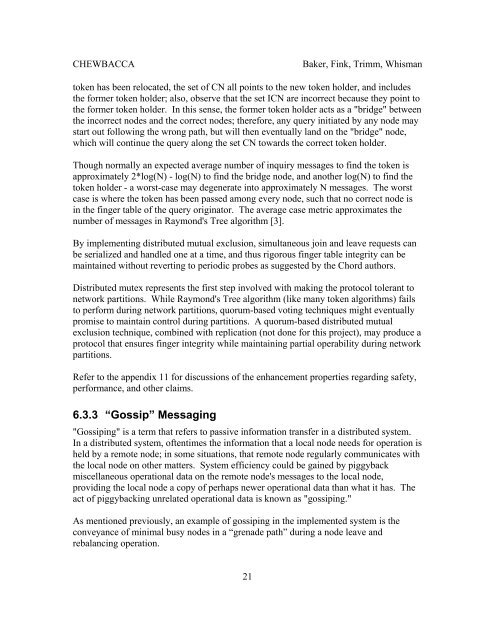Implementing a Distributed Peer to Peer File Sharing System ... - Umbc
Implementing a Distributed Peer to Peer File Sharing System ... - Umbc
Implementing a Distributed Peer to Peer File Sharing System ... - Umbc
You also want an ePaper? Increase the reach of your titles
YUMPU automatically turns print PDFs into web optimized ePapers that Google loves.
CHEWBACCA Baker, Fink, Trimm, Whisman<br />
<strong>to</strong>ken has been relocated, the set of CN all points <strong>to</strong> the new <strong>to</strong>ken holder, and includes<br />
the former <strong>to</strong>ken holder; also, observe that the set ICN are incorrect because they point <strong>to</strong><br />
the former <strong>to</strong>ken holder. In this sense, the former <strong>to</strong>ken holder acts as a "bridge" between<br />
the incorrect nodes and the correct nodes; therefore, any query initiated by any node may<br />
start out following the wrong path, but will then eventually land on the "bridge" node,<br />
which will continue the query along the set CN <strong>to</strong>wards the correct <strong>to</strong>ken holder.<br />
Though normally an expected average number of inquiry messages <strong>to</strong> find the <strong>to</strong>ken is<br />
approximately 2*log(N) - log(N) <strong>to</strong> find the bridge node, and another log(N) <strong>to</strong> find the<br />
<strong>to</strong>ken holder - a worst-case may degenerate in<strong>to</strong> approximately N messages. The worst<br />
case is where the <strong>to</strong>ken has been passed among every node, such that no correct node is<br />
in the finger table of the query origina<strong>to</strong>r. The average case metric approximates the<br />
number of messages in Raymond's Tree algorithm [3].<br />
By implementing distributed mutual exclusion, simultaneous join and leave requests can<br />
be serialized and handled one at a time, and thus rigorous finger table integrity can be<br />
maintained without reverting <strong>to</strong> periodic probes as suggested by the Chord authors.<br />
<strong>Distributed</strong> mutex represents the first step involved with making the pro<strong>to</strong>col <strong>to</strong>lerant <strong>to</strong><br />
network partitions. While Raymond's Tree algorithm (like many <strong>to</strong>ken algorithms) fails<br />
<strong>to</strong> perform during network partitions, quorum-based voting techniques might eventually<br />
promise <strong>to</strong> maintain control during partitions. A quorum-based distributed mutual<br />
exclusion technique, combined with replication (not done for this project), may produce a<br />
pro<strong>to</strong>col that ensures finger integrity while maintaining partial operability during network<br />
partitions.<br />
Refer <strong>to</strong> the appendix 11 for discussions of the enhancement properties regarding safety,<br />
performance, and other claims.<br />
6.3.3 “Gossip” Messaging<br />
"Gossiping" is a term that refers <strong>to</strong> passive information transfer in a distributed system.<br />
In a distributed system, oftentimes the information that a local node needs for operation is<br />
held by a remote node; in some situations, that remote node regularly communicates with<br />
the local node on other matters. <strong>System</strong> efficiency could be gained by piggyback<br />
miscellaneous operational data on the remote node's messages <strong>to</strong> the local node,<br />
providing the local node a copy of perhaps newer operational data than what it has. The<br />
act of piggybacking unrelated operational data is known as "gossiping."<br />
As mentioned previously, an example of gossiping in the implemented system is the<br />
conveyance of minimal busy nodes in a “grenade path” during a node leave and<br />
rebalancing operation.<br />
21











